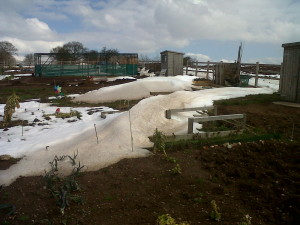January is traditionally a quiet month down at the allotment, but then that is usually down to the fact the weather is cold and wet. However, for those who are either willing to brave the elements or lucky enough to get decent weather there is still plenty of work to do.
Vegetables
 Whilst the ground is frozen you are best to not put anything directly into it, but you can start plants off in your greenhouse, on your windowsill or in your polytunnel.
Whilst the ground is frozen you are best to not put anything directly into it, but you can start plants off in your greenhouse, on your windowsill or in your polytunnel.
For the flower gardener now is the time to start your sweet peas, in a gentle heat, as well as pansies, geranium, begonia and lobelia. These can all be started off indoors so they are ready for the planting season and an early splash of colour.
In the greenhouse you can start off your celery and celeriac in a heated propagator as well as start off your herbs on your windowsill. Onion seeds need sowing now as this gives them the chance to grow as big as possible, important if you are showing them.
If you are growing rhubarb then now is a good time to get it in the ground. You can force it under a cloche but be aware this exhausts the plant and it will need a rest next year.
Your first early potatoes can also start chitting now. Put them on a bright windowsill and let them get started for planting in 3 to 6 weeks.
If the ground isn’t frozen then you can sow a hardy broad bean variety directly into the soil. You may have overwintered some broad beans and these will give you a more continuous crop throughout the fruiting season.
You can also sow seeds such as aubergene (eggplant), cabbage, carrot, cauliflower and more. All of these can get a head start and then be planted out when the weather is suitable.
If you still have Brussels sprouts in the ground they may start to look a bit leggy and become vulnerable to being blown over by the wind. If this is the case then either stake them or earth them up. Remember to start picking the bigger sprouts from the bottom of the stalk first.
Fruit
Not much is happening in the fruit garden at this time of year but it is the best time to prune your fruit plants such as apples, pears, medlars and quinces. Autumn raspberries can also be cut back at this time of year as can gooseberries and currants.
Check your apple trees for any signs of canker and if there are any then prune it out and destroy the damaged wood.
All fruit and nut trees will benefit from a top dressing sulphate of potash at this time of year.
General Maintenance
There is a lot of other work you can be doing down at your plot too. Seed beds can be prepared for planting; dig in manure or compost, weed and then cover with fleece or polythene so it warms the soil before planting. If you have a very heavy soil then don’t cover the soil, leave it exposed to the elements as this will kill off pests and help improve the structure of your soil. For heavy soils you should also work in organic matter now as that is going to help improve drainage.
Most of us are going to have wet soil at this time of year and standing on it compacts the soil so work your soil from a plank of wood. This makes it easier to dig, ensures the soil is a better quality when you plant and stops you loosing a shoe or boot in the mud!
Anyone who has stored fruit or vegetables over winter needs to check them. You may need to put something to control mice in place as they are going to start appearing soon and be hungry. Any rotten or damaged produce needs to be removed from the store and used otherwise it will cause the rest of your produce to rot and go bad.
Remove fallen leaves and other plant debris from your vegetable plot as these are going to provide a perfect hiding place for pests such as slugs and snails.
























Speak Your Mind